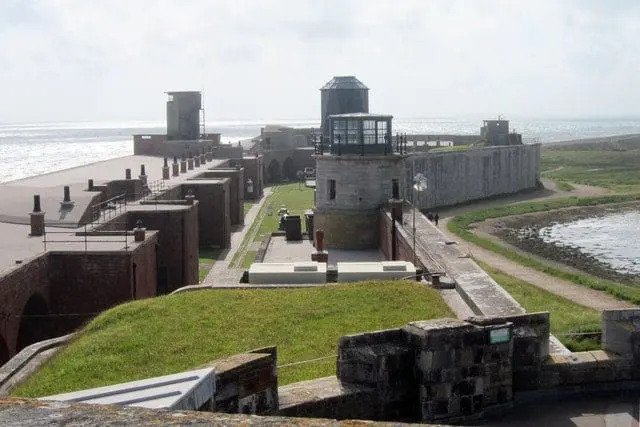Your basket is currently empty!

Hurst Castle
With its distinctive angular bastions and imposing walls, Hurst Castle has safeguarded the approaches to the Isle of Wight and the English Channel for over 450 years. Built by command of Henry VIII in the 1540s to defend against possible French invasion, Hurst Castle formed part of an ambitious chain of Device Forts equipped with the latest artillery technology.

Since then, it has played notable roles in the English Civil War, both World Wars, and has seen many extensions and upgrades throughout its long history. Today, English Heritage carefully preserves Hurst Castle and operates it as a museum where visitors can step back in time to explore its winding passages, imposing ramparts, and extensive displays of artefacts. With sweeping views across the Solent, immersive exhibits and a calendar of special events, Hurst Castle offers a unique window into the coastal defence heritage of England.

History of Hurst Castle
The origins of Hurst Castle date to the 1540s, when Henry VIII directed his Lord High Admiral to oversee the construction of a small artillery fort on the Hurst spit. Designed by Italian military engineer Stefan von Haschenperg, the fort formed part of Henry’s ambitious chain of Device Forts built to defend the realm using the latest continental innovations in artillery fortifications.
Over the next century, Hurst Castle saw additions including the prominent flanking bastions still visible today. During the English Civil War, the castle was held for Parliament and shelled extensively by Royalist forces. It continued to play an important defensive role guarding the Solent through the 18th century.

In the 19th century, Hurst became a political prison, most notably incarcerating King Charles I before his execution in 1649. Extensive Victorian upgrades in the 1860s gave the castle much of its current appearance. During World War I and II, Hurst returned to service as a critical part of British coastal defences.
After World War II, sections of the castle were decommissioned by the military. In the 1950s, the site opened to visitors under the management of the Ministry of Works. Further restorations were completed in the 1990s to secure and preserve the remains of this Scheduled Ancient Monument for future generations.
Site Layout and Architecture
Approaching from the landward side, visitors first encounter the imposing Tudor walls of the Lower Ward. This outer section of the castle is characterised by angular protruding bastions designed for heavy artillery batteries with overlapping fields of fire. The walls form an irregular pentagon shape, allowing enfilading fire along the base of the ramparts.
Originally, Hurst Castle was centred around an inner keep, demolished in the 1700s. The remains include a central parade ground, gunpowder store and the foundations of the former keep. Sturdy brick-arched passageways connect the seaward firing platforms known as the Shooting Rooms.
Spanning the moat is a stone bridge leading to the Upper Ward, which houses the main living quarters. The Tudor-era lodgings have intricate brickwork façades in the fashionable style of the period. The Victorian barracks and officers’ mess reflect later expansions. Throughout the castle, informative displays of artefacts, uniforms, arms and period furnishings bring the history alive.
With striking views over the Solent, Hurst Castle evokes the changing architecture and innovations of English coastal fortifications through the centuries, from Tudor bulwarks to Victorian gun batteries. The distinctive silhouettes of the bastions and imposing ramparts transport visitors back through time.

Present Day Hurst Castle
Today, English Heritage cares for Hurst Castle as an iconic monument and popular heritage attraction. Open seasonally from March to October, the site offers immersive exhibits detailing the castle’s long operational history and changing role over the centuries.
Costumed interpreters bring the past to life and show visitors the workings of period artillery. The castle rooms house displays of uniforms, weapons, photographs and models illustrating Hurst’s military heritage. The substantial collections provide insight into Britain’s coastal defences as well as the lives of those who served at Hurst.
In addition to self-guided exploration, families can take part in hands-on activities and school programmes. Special events like re-enactments, concerts and holiday festivals make full use of the atmospheric setting. The castle’s West Wing tearooms provide light refreshments with scenic outdoor seating.
A highlight for many are the panoramic views from the ramparts taking in the Isle of Wight, the Needles rocks and miles of coastline. With an easily accessible location and modern facilities, Hurst Castle remains one of the south coast’s premier historic attractions.
How to find Hurst Castle
Hurst Castle, Cliff End, Norton, Freshwater, Isle of Wight, England, PO40 9TB, United Kingdom
Places to Stay near Hurst Castle
Discover more from Histories and Castles
Subscribe to get the latest posts sent to your email.
-
Quartz Point Crystal Wand – Medieval Magic and Mindfulness
£19.25 -
Viking Wolf Knot Ring | Norse Knotwork Wolf Jewellery
£10.76 – £10.89 -
Viking Letter Ring | Norse Initial Runes Jewellery
£14.90 – £15.16 -
Nordic Viking Rune Spinner Ring | Viking Jewellery
£12.20 – £12.45 -
Ancient Egyptian Ankh Gigcoil Necklace
£37.58 – £62.45 -
Viking Linen Table Runner | Nordic Table Décor
£12.24 – £13.03












